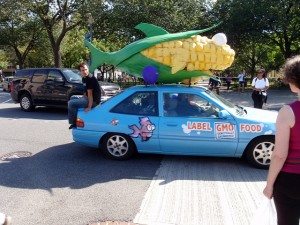How California’s GMO Labeling Law Could Limit Your Food Choices and Hurt the Poor
The American Medical Association resolved this week that “there is no scientific justification for special labeling of bioengineered foods.”
The association has long-held that nothing about the process of recombinant DNA makes genetically engineered (GE) crop plants inherently more dangerous to the environment or to human health than the traditional crop plants that have been deliberately but slowly bred for human purposes for millennia. It is a view shared by the National Academy of Sciences, the World Health Organization, the Food and Agriculture Organization of the U.N., the European Commission, and countless other national science academies and non-governmental organizations.
And yet Californians will consider on their November ballots a law that mandates cigarette-like labeling of food derived from GE plants. Proponents claim to promote opportunities for consumers to make informed choices about the foods they eat. But to build support for the measure, they have played on consumer fears about a promising technology that is nevertheless prone to “Frankenfoods” demagoguery. If successful, they may well imperil the ability of Californians, and consumers around the world, to choose a technology that scientists contend could end hunger and malnutrition, lift hundreds of millions from poverty, and reduce the environmental impact of feeding an evermore populous world.
“Currently available genetically modified foods are safe to eat.” That was the conclusion of a 2003 inquiry by the International Council for Science, an NGO representing the national science academies of 140 countries, including the U.S. It is a finding repeatedly made by the U.S. National Research Council. The U.S. Department of Agriculture, the Food and Drug Administration, and the U.S. EPA all regulate the use of genetically engineered plants in the U.S. according to a philosophy endorsed by the scientific community that the content and characteristics of plants and foods should govern their regulatory scrutiny, not the process by which they are made.
Voluntary certified organic labels already allow consumers to avoid GE foods. Given the dramatic fissure between scientific opinion and public perception—only one in four consumers thinks GE foods are “basically safe”—a mandatory labeling regime is likely only to cripple crop science by reducing market share and revenues to GE food producers.
More devastating than the label itself, could be the cost of avoiding the label on non-GE foods that may nevertheless contain trace amounts of GE material. In the U.S., the highest-grade corn can contain as much as 2% foreign material, like crop residues. In Europe, a food product can contain as much as 0.9% genetically engineered material and avoid a GE label. But the California law would impose a nearly twice as stringent purity standard, tolerating only 0.5% GE content in non-GE food.
Such a high purity standard would likely require farmers to invest in separate planting, harvesting, storage, hauling, processing, and packaging equipment for GE production in order to avoid revenue losses and liability from contaminating their non-GE operations or those of competitors. Because the costs of risk reduction generally increase exponentially in the level of safety, California’s stringent purity standard may be a death sentence to GE producers who could spread the high fixed costs of contamination avoidance across only the low levels of production that the market would initially support.
Facing diminished revenue prospects and high fixed costs to prevent even trace contamination, processors may abandon GE production altogether. Farmers would stop planting GE crops, and scientists would stop agricultural biotechnology research. Much as a decade-long moratorium on GE crops in Europe caused the agricultural biotechnology R&D pipeline to contract around the world, a labeling regime in the most populous state of the world’s most aggressive GE-adopting country could cause firms to shelve potentially life-saving innovations. Food prices would rise and consumer choice would be diminished.
Existing applications of agricultural biotechnology allow better control of pests by encoding plant DNA to either produce a naturally occurring and widely used insect toxin or generate immunity to a relatively low toxicity, broad spectrum herbicide marketed as Round-Up. By improving the control of insects or weeds, the technologies reduce crop damage, raising crop yields, lowering food prices, and saving natural habitat from cropland expansion.
An exhaustive review by the National Research Council in 2010 concluded that existing GE technologies reduce insecticide applications, support the substitution of low toxicity herbicides for more toxic alternatives, and encourage the use of no-till operations that reduce soil erosion and support soil carbon sequestration. They also permit double-cropping, a practice whereby farmers successively plant two crops per growing season, essentially doubling the productivity of existing land.
Forthcoming and prospective GE crops hold greater promise. They include staple crops with improved nutrient content to reduce malnutrition in the developing world and field crops that tolerate the climatic extremes experienced in some of the poorest parts of the world.
Norman Borlaug was the 20th century savior of the poor and hungry. Wearing coveralls and toiling in Mexican fields with conventional breeding techniques, he launched the Green Revolution and saved millions of lives, for which he received the Nobel Peace Price in 1970. His 21st century counterparts wear lab coats and stare into microscopes on university campuses and in the research departments of multinational corporations. They advance the same science to which Borlaug devoted his life and do work that he whole-heartedly endorsed unto his death. For many of today’s crop scientists, his goals are theirs. But their tools are better and their potential is greater.
If only Californians will give them a chance.


Comments